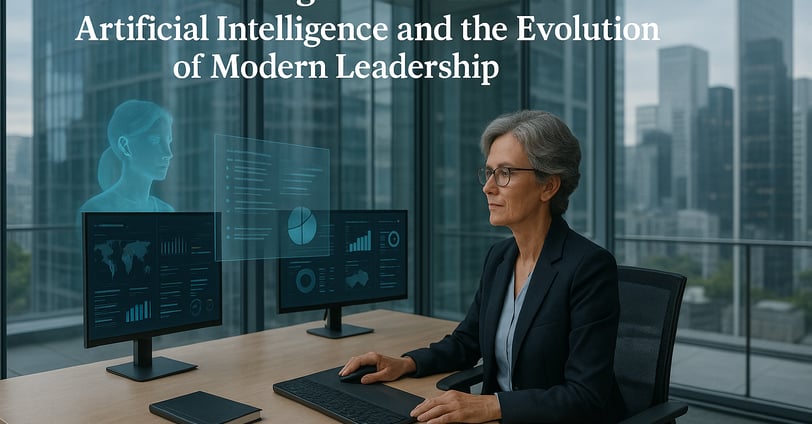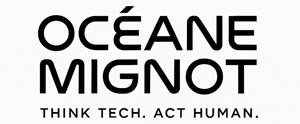The Augmented Executive: Artificial Intelligence and the Evolution of Modern Leadership
This article explores how AI is transforming leadership—from decision-making and talent development to ethics and strategy. Through real-world examples, it highlights how today’s executives must blend data-driven insights with human judgment to lead effectively in an AI-powered world.
Océane Mignot
7/2/20244 min read


The integration of artificial intelligence (AI) into corporate governance has transitioned from speculative futurism to operational reality. By 2025, AI has become a cornerstone of managerial decision-making, talent development, and strategic foresight, redefining the competencies required for effective leadership. This transformation is not merely technological but cultural, demanding a synthesis of human intuition and machine precision. From predictive analytics in manufacturing to AI-driven coaching in HR, organizations are navigating a paradigm shift where executives must balance algorithmic insights with ethical stewardship.
The Reinvention of Decision-Making
From Gut Instinct to Data-Driven Strategy
The traditional executive’s reliance on experience and intuition is being supplanted by AI’s capacity to process vast datasets and identify imperceptible patterns. By 2024, 92% of enterprises had increased investments in AI-driven decision-support systems, prioritizing predictive analytics and real-time optimization1. Retail giant Walmart, for instance, deployed its generative AI tool “Wally” in 2025 to assist merchants in diagnosing product performance, automating complex forecasts, and streamlining supply chain decisions—reducing manual reporting time by 70%2.
Hybrid Decision Architectures
A three-stage model now dominates strategic planning:
1. Data Aggregation: IoT sensors, transaction logs, and social sentiment analysis feed into centralized systems.
2. AI Analysis: Machine learning models highlight risks, opportunities, and market shifts.
3. Human Judgment: Executives contextualize insights, weighing ethical and cultural factors3.
Siemens’ 2024 integration of generative AI into its Senseye Predictive Maintenance platform exemplifies this fusion. The system processes equipment data to predict failures but delegates final repair decisions to engineers, who incorporate operational context and safety protocols4.
Leadership in the Algorithmic Age
The Rise of Computational Leadership
The concept of “computational leadership,” first articulated by organizational theorist Brian Spisak, emphasizes three pillars:
Data Literacy: Interrogating AI outputs for bias and relevance.
Interdisciplinary Collaboration: Bridging gaps between technical and operational teams.
Strategic Foresight: Aligning AI capabilities with long-term organizational goals5.
IBM’s 2024 “Skills Gateway” platform operationalizes this framework, using AI to map employee competencies against future skill gaps and recommend personalized learning pathways. Over 90% of participants reported acquiring critical new skills, such as prompt engineering for generative AI tools6.
AI as a Leadership Coach
Startups like BetterUp have pioneered AI coaching platforms that simulate leadership scenarios, offering real-time feedback on communication styles and decision-making patterns. In 2025, BetterUp’s AI coaches were adopted by 40% of Fortune 500 firms, complementing human mentors in developing empathy and conflict-resolution skills7.
The Talent Revolution: Reskilling for an AI-Driven Economy
Closing the Skills Gap
The World Economic Forum estimates that 50% of employees will require reskilling by 2027 due to AI adoption8. Alibaba’s 2025 initiative to achieve 100% AI tool adoption among its 200,000 merchants underscores this shift. The company’s AI agents now handle marketing, customer service, and inventory management, freeing human workers to focus on strategic partnerships and innovation9.
Ethical and Regulatory Challenges
The EU AI Act (2025) classifies HR tools as “high-risk,” mandating transparency in recruitment algorithms and human oversight in layoff decisions10. Amazon’s 2018 AI recruitment tool, which penalized resumes containing the word “women,” remains a cautionary tale, prompting stricter bias audits and diversity dashboards industry-wide11.
Industry Case Studies: AI in Action
Manufacturing: Predictive Maintenance 2.0
Siemens’ Senseye platform, enhanced with generative AI in 2024, now prescribes maintenance actions through natural language interfaces. BlueScope Steel reported a 25% reduction in downtime after adopting the system, which correlates historical data with real-time sensor inputs12.
Retail: Personalization at Scale
Netflix’s AI engine analyzes 1.5 billion hours of monthly viewer data to recommend content, but human curators refine these suggestions to align with brand identity and cultural trends13. This hybrid approach has sustained a 93% customer retention rate despite streaming market saturation.
Governance and the Future of Ethical AI
The EU AI Act: A Global Benchmark
Effective 2026, the EU’s regulatory framework imposes fines of up to 4% of global revenue for non-compliance with AI ethics standards. Key requirements include:
Algorithmic Audits: Annual reviews of AI decision-making patterns.
Explainability: Providing plain-language rationales for AI-driven HR or operational decisions14.
Corporate Accountability Frameworks
Companies like Unilever now employ “AI Ethics Committees” to oversee deployments. These cross-functional teams—comprising data scientists, legal experts, and employee representatives—evaluate projects for fairness, privacy, and societal impact15.
Conclusion: The Hybrid Executive
The AI-augmented leader of 2025 thrives not by mastering algorithms but by orchestrating synergies between human and machine intelligence. Key imperatives include:
1. Cultivating Data Fluency: Understanding AI’s strengths and limitations.
2. Prioritizing Ethical Governance: Embedding transparency into AI workflows.
3. Investing in Adaptive Talent: Reskilling workforces for roles requiring creativity and emotional intelligence.
As Siemens CEO Roland Busch observes, “The factories of the future will be run by AI—but they will be led by humans who ask the right questions.”16 In this equilibrium lies the competitive advantage of the next decade.
Sources :
1: IBM Institute for Business Value, 2024 Global AI Adoption Index.
2: PYMNTS, Walmart Develops AI Assistant for Merchants, March 2025.
3: McKinsey & Company, AI-Powered Decision Making in Banking, 2024.
4: Siemens AG, Generative AI in Predictive Maintenance, February 2024.
5: Harvard Business Review, Computational Leadership: A New Paradigm, October 2024.
6: IBM, Skills Gateway Impact Report, 2024.
7: BetterUp, 2025 AI Coaching Adoption Survey.
8: World Economic Forum, The Future of Jobs Report 2024.
9: South China Morning Post, Alibaba’s AI Adoption Strategy, March 2025.
10: Deel, EU AI Act Compliance Guide, April 2025.
11: Reuters, Amazon’s Biased Recruitment Algorithm, 2018.
12: Manufacturing Tomorrow, Siemens’ AI-Driven Maintenance, 2024.
13: AI Perceiver, Netflix’s Recommendation Engine, 2025.
14: RemoFirst, EU AI Act for HR Leaders, March 2025.
15: Deloitte, AI Governance in Multinational Corporations, 2025.
16: Roland Busch, Keynote at Hannover Messe, April 2025.
Océane Mignot
Think Tech - Act Human
Contact me...
oceane.mignotblog@gmail.com
© 2025. All rights reserved.
